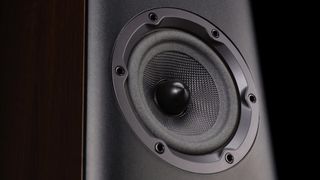What Hi-Fi? | 19 Jul 2019
Easy-going and well made entry-level floorstanders
To the UK-based audiophile, Wharfedale needs little introduction. The game-changing Diamond speaker series from 1981 still tops the firm’s product list today – albeit in its 11th iteration. But here, we’re testing an even more budget-conscious line in Wharfedale’s arsenal.
Compatibility

The D300 Series has been designed to run concurrently with the Diamond 11 range. According to Wharfedale, it harnesses the same key technology, but re-engineers and presents it at an even more affordable price-point.
The Wharfedale D330s are the only floorstanders of the range, combining a 25mm soft dome tweeter with a pair of 13cm woven Kevlar drivers in a 2.5-way configuration. Below them are two standmounters, the D320 and D310.
Build

The rosewood finish of our D330s is easy on the eye. With their curved edges and minimal branding, they look and feel more expensive than they actually are. That’s no surprise, as the D330s were originally priced at £499, before enjoying a substantial price drop.
Rather than having a grille that covers the entire baffle, every driver has its own circular grille that can be easily detached via rubberised fixings. Whether the grilles are on or off, the towers look sleek, but not overstated, with maybe the tiniest hint of 80s retro. The D330s are instantly likeable.
There is no visible reflex port in the D330s, which leads us to the Wharfedale’s P-EQ bass reflex port – tech you’ll be hard pressed to find in any other entry-level pair of floorstanders.
Developed from the slot-loaded distributed port found in the Diamond 11 Series, the D300 Series’ P-EQ (Pressure Equalisation) port system means that low frequencies are emitted from the base of the speaker, with precisely engineered curved openings to smooth and regulate airflow.
These frequencies enter the room through a space between the cabinet and the plinth on which it rests. The theory is that it permits a deep and controlled bass performance, with the speakers able to be placed closer to a wall than those with rear-firing ports, without compromising on performance.
Sound

We play Party In The Dark by Mogwai, moving our D330s close to the wall to test the placement claims. Despite the wide distribution, we find that the speakers are better suited at 50cm away from the wall – in our test room at least.
Once in position, the opening soundscape is clean, deep, controlled and full-bodied. The dissonant guitar crescendo fizzes up before the snappy bass riff takes over, with an eventual crash of drums that never imposes on Stuart Braithwaite’s augmented vocal. It’s an unusually strong bass performance in a pair of floorstanders at this level.
We switch to Maxwell’s Gods, and it’s clear that the D330’s drivers are well integrated; vocals are precise and textured with a sensitive and pleasingly understated treble. The echo effect through the synthesizer at the start of the track, like droplets into water, is perky and tonally convincing, but it lacks the finesse and dynamic detail of the class-leading, but more expensive, Fyne Audio F302s.
There is method here, though. The D330s will perform comfortably regardless of the source material or set-up they’re presented with, offering a full-bodied, easy-going sound that’s never over-zealous through the upper registers.
For a budget speaker, it’s a sensible balance, but we become aware of some minor issues with timing here. The drumbeat feels incidental – it never sounds as though it’s driving the track – making for a less exciting and less emotional listen.
In playing it safe, the D330s don’t communicate oodles of excitement. By focusing so resolutely on trying not to offend, do the Wharfedale D330s actually manage to offend us? Not quite. Although Wharfedale’s subtle approach means we lose out on that extra injection of excitement and detail, there is a big sound on offer here – it’s a pleasant listen across a range of music.
Verdict
There’s no denying that the D330s are restrained performers, always opting for a softer landing. That said, if you’re looking for an affordable, unfussy floorstander these are still worthy of your consideration.
Despite being beaten for transparency and detail by the Fyne Audio F302s, previous Award-winners at this level, the treble is less crude sounding and there’s more subtlety on offer.
There’s also a marginally deeper bass available, albeit accompanied by a slight shortfall in dynamics and excitement. The Wharfedale D330s present an expansive, warm, congenial, safe option – rather than a dramatic one, and in certain circumstances that may be the right choice.